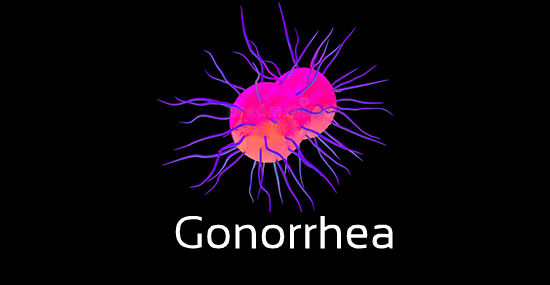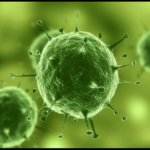Gonorrhea Symptoms Causes and Treatment
What is gonorrhea?
Gonorrhea (gonorrhoea, гонорея, مرض السيلان) is a sexually transmitted infectious disease (STI) caused by infection with Neisseria gonorrhoeae or gonococcus, a pathogenic gram negative bacteria in the genus Neisseria. When an infection is present, signs and symptoms are usually expressed in early stages, early symptoms include dysuria, and penile or vaginal discharge (white, yellow, or green); However, many men with gonorrhea are asymptomatic, especially in early stages of gonorrhea.

Gonorrhoea or the clap is a very common infectious disease, especially among people ages 15-24.
Neisseria gonorrhoeae may cause pharyngitis, urethritis, proctitis, cervicitis, arthritis, pelvic inflammatory disease, sepsis, and skin infection.

Pathogen – Neisseria gonorrhoeae or gonococcus.
Epidemiology
How do you get the clap?
The source of infection:
In most cases, gonorrhoea is caught from other humans (pathogen carriers and sick people).
Mechanism of transmission:
How gonorrhea can be transmitted?
Also called the clap, Gonorrhea can infect both men and women. It can cause infections in the throat, genitals, and rectum. The bacteria are mainly found in penile discharge and in vaginal fluid.
Neisseria gonorrhoeae is usually transmitted by means of contact with penile or vaginal discharge, through unprotected oral, vaginal, or anal sex with an infected partner. Ejaculation does not have to occur for people to get infected with Neisseria gonorrhoeae.
Gonorrhea can also be spread by vertical transmission of Neisseria gonorrhoeae from an infected mother to her child (mother-to-child transmission, MTCT).
How long does it take for a person to get gonorrhea?
The incubation period for gonorrhea ranges from 2 to 30 days.
Gonorrhea is characterized by an acute onset, symptoms usually develop suddenly and progresses rapidly. However, around 20 percent of men and about 80 percent of women with gonorrhea are asymptomatic, especially in early stages of gonorrhea.
How long can you have gonorrhea without knowing?
If left untreated, gonorrhea can spread into the uterus or fallopian tubes and women usually develop Pelvic inflammatory disease (PID) in a period ranging from 2 days to 3 weeks. In most cases, symptoms may show up 2 to 5 days after initial exposure (after infection). PID is a serious complication of gonorrhea, which can cause permanent damage to the reproductive organs and can lead to severe gynecological problems such as: chronic pelvic pain, infertility and can increase the risk of ectopic pregnancy.
Gonorrhea is considered a silent infection and it may take as long as 30 days before symptoms start.
How long does it take for gonorrhea symptoms to go away?
If gonorrhea is present, tell your sexual partner(s) that you have a sexually transmitted disease, partners and couples should be tested and treated. This is a strategy known as test and treat all. You may become infected again and again unless both you and your partner get treatment. If your treatment involves a single dose of antibiotics, abstain from sex for at least a week after treatment.
Symptoms
What are the symptoms of gonorrhea in women?
Symptoms of gonorrhea in women include:
- Dysuria or burning sensation while urinating
- Heavier than normal menstrual flow (menorrhagia) with or without spotting
- Sore throat due to pharyngitis or tonsillitis
- Dyspareunia or painful sexual intercourse
- Sharp abdominal pain, especially in the lower abdomen
- Bilateral, inguinal lymphadenopathy
- Uterine or adnexal tenderness and cervical motion tenderness
- Fever
- Pelvic pain that radiates into the thighs is sometimes present
- Urethral and vaginal discharge
What does the discharge look like when you have gonorrhea?
- Urethral discharge (white, yellow, or green), it usually appears 1-14 days after infection
- Vaginal discharge (watery, creamy, or slightly green)

What are the symptoms of gonorrhea in males?
Symptoms of gonorrhea in males include:
- Dysuria or burning sensation while urinating
- Urinary hesitancy, facing difficulty in starting or maintaining a urine stream
- Urinary frequency, but the amount of urine passed is relatively small
- A cloudy white penile discharge from the tip of the penis in the morning
- Meatus glued up in morning with a thick yellowish-green drop
- Presence of blood in the urine (hematuria)
- Presence of blood in the semen (Hematospermia)
- Sore throat due to pharyngitis or tonsillitis
- Itching or irritation on the tip of the penis
- Inflammed and irritated meatus
- Discomfort that occurs during sex, and painful ejaculation
- Low grade fever

Can the symptoms of gonorrhea come and go?
Many people with gonorrhea are asymptomatic, especially in early stages of gonorrhea. However, if you are asymptomatic, that does not mean that there are no pathogens in your body and unless gonorrhea is treated, the bacteria will remain in your body. This simply means you can pass on the infection to others and disease may erupt at any time without any prior warning. If left untreated, gonorrhea can cause infertility.
Do STDs go away?
In most cases, symptoms can come and go, but gonorrhea is still contagious with or without symptoms, and it will not go away without treatment.
Can you get a rash from gonorrhea?
If left untreated, the infection will continue to spread and it can cause flu-like symptoms and skin rash, especially on the chest, palms, and limbs. In very rare cases, the infection can spread to your joints and tendons causing pain and difficulty moving (arthritis and tendonitis).
Causes
What is the cause of gonorrhea?
Gonorrhea is a bacterial infection caused by infection with Neisseria gonorrhoeae, a pathogenic gram negative bacteria in the genus Neisseria.
Gonorrhea is a sexually transmitted infection that can be sexually transmitted from one person to another.
Neisseria gonorrhoeae infects the mucus membranes, and for this reason, the bacteria can also affect the eyes, mouth, throat, urethra, cervix, vagina, and rectum of an infected individual.
Diagnosis
How to diagnose gonorrhea?
To determine whether Neisseria gonorrhoeae is present in your body, your doctor will collect samples to analyze them.
How do you get tested for gonorrhea?
Tests include:
A standard STD panel is a test package, in which urine and blood samples are collected to check for common sexually transmitted diseases. This full STD panel tests for gonorrhea, syphilis, chlamydia, herpes, hepatitis A, hepatitis B, hepatitis C and HIV.
An early morning urine sample is obtained to check for the presence of the gonorrhea bacteria.
How soon can you get tested for gonorrhea and how accurate is a gonorrhea test?
For accurate results, doctors recommend waiting 2-14 days after sexual exposure before taking this full STD panel test.
It is recommended to wait few days after unprotected intercourse before getting tested to get rid of false negative test results, as most results are accurate after after 7 days. And for this reason, doctors may suggest getting tested 6-7 days after sex.
How long does it take for gonorrhea to show up positive on a test?
Gonorrhea can show up on the test 2-14 days after sexual exposure, often before you have symptoms; however, for absolute certainty a test 7 days after unprotected intercourse is best.
When to retest for gonorrhea after treatment?
Retesting 30 days after treatment to ensure that the infection has been cured. Get retested again 90 days after treatment to make sure the infection did not reappear.
Can gonorrhea be detected in a blood test?
An early morning urine sample is required to test for gonorrhea. Do not urinate for 2-3 hours before doing the test.
A swab test is a non invasive procedure, in which a sample of fluid is obtained from the urethra, cervix or vagina to check for the presence of Neisseria gonorrhoeae.
In males, a sample of fluid is collected from the urethra, urethral swabs are performed to test for the presence of Neisseria gonorrhoeae.
In females, a swab is used to collect a sample of fluid from the cervix, cervical swab specimens are then sent to a lab for analysis. This can be done during a routine Pap test. Throat or anal culture may be performed to see if the infection is in your throat or anus.

Make sure not to do a vaginal douche and not to use vaginal creams and vaginal applications for at least 24 hours before doing the test.
Treatment
What is the treatment of gonorrhea?
How to treat Gonorrhea?
The recommended gold standard treatment for gonorrhea is a combination of intravenous antibiotics and oral antibiotics. Adults with gonorrhea are treated with either iv ceftriaxone or iv ceftriaxone in combination with either azithromycin (Zithromax, Zmax) or doxycycline (Monodox, Vibramycin, others) that are taken orally at the same time, this helps treat coinfection with chlamydia trachomatis (it is common for people to get both infections together). Alternatively, people who are allergic to cephalosporin antibiotics, such as ceftriaxone are successfully treated with oral gemifloxacin (Factive) or iv gentamicin in combination with oral azithromycin.
Gonorrhea treatment for partners
If gonorrhea is present, your sexual partner(s) should be tested and treated even if he or she has no signs or symptoms. This is a strategy known as test and treat all. You and your partner(s) should be given the same treatment at the same time. Abstain from sex for at least 1 week after the start of treatment.
Gonorrhea treatment for babies
Babies born to mothers with gonorrhea can be treated with a topical ointment, antibiotic ointment (erythromycin, or tetracycline) is typically applied to the baby’s eyes during the first hour or so after birth to prevent gonococcal ophthalmia.

If neonatal conjunctivitis (ophthalmia neonatorum) develops, babies can be treated with 25-50 mg/kg of ceftriaxone in a single intramuscular or intravenous dose. The dose should not exceed 125 mg.
To confirm the presence of a STD in the neonate (the first 4 weeks of a child’s life), examine and treat the baby and the mother.
Babies with neonatal conjunctivitis should be treated for gonococcal conjunctivitis until culture results are obtained because of the fast progression of gonococcal conjunctivitis.
This infection is treated with erythromycin 50 mg/kg/d po divided qid for 14 days. A second course of antibiotics after 2 weeks is sometimes required because the efficacy of systemic erythromycin therapy is approximately 80%.
Topical erythromycin ointment alone is ineffective. However, a combination of topical antibiotics and oral antibiotics can be used to increase treatment effectiveness and efficiency.
What medication is used to treat gonorrhea?
Penicillins, fluoroquinolones (ciprofloxacin, levofloxacin, moxifloxacin), or erythromycin are not commonly prescribed as a first-line therapy for gonorrhea due to increasing antibiotic resistance to these strains, especially in the United States
The following antibiotics are commonly prescribed to treat gonorrhea:
- Azithromycin (Zithromax, Zmax)
- Doxycycline (Vibramycin, Doxy)
- Ceftriaxone (Rocephin)
- Cefixime (Suprax)
- Erythromycin ophthalmic (Ilotycin Ophthalmic)
Prevention
How to Prevent gonorrhea?
You can help to prevent the spread of gonorrhea by:
- Avoid having multiple partners and casual sex
- Avoid polyamory
- Not sharing sex toys
- Use a new condom every time you have sex
- If you’ve got an STI, inform your sexual partner(s) and abstain abstain from sex for at least 1 week after the start of treatment
- Get tested for STIs regularly

How can I avoid getting gonorrhea?
References
Verified by: Dr.Diab (December 19, 2023)
Citation: Dr.Diab. (December 19, 2023). What is Gonorrhea? Symptoms Causes and Treatment. Medcoi Journal of Medicine, 28(2). urn:medcoi:article17714.














There are no comments yet
Or use one of these social networks